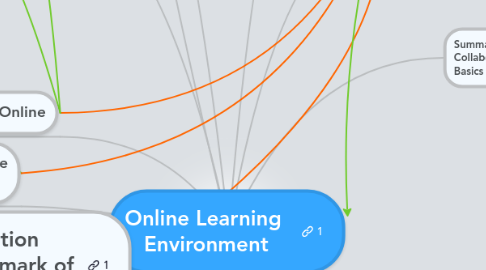
1. Communication & Interaction
1.1. Google Drive
1.2. Illuminate
1.3. chat
1.4. email
1.5. telephone
2. Collaboration - The Hallmark of Constructivism
2.1. Promotes
2.1.1. Development of Critical Thinking Skills
2.1.2. Co-creation of Knowledge & Meaning
2.1.3. Assists Deeper Levels of Knowledge Generation
2.1.4. Transformative Learning
2.1.5. Reflection
2.2. Allows Students to
2.2.1. Create Shared Goal for Learning
2.2.2. Form Foundation for Community Learning
2.3. Addresses
2.3.1. All learning styles
2.3.2. Issues of culture
3. Why Collaborate Online
3.1. Social Presence Minmize Isolation
3.1.1. Social Context
3.1.2. Online Communication
3.1.3. Interaction
3.2. Elements of Community
3.2.1. People
3.2.1.1. Students
3.2.1.2. Faculty
3.2.1.3. Staff
3.2.2. Shared Purpose
3.3. Guidelines
3.3.1. General Structure
3.3.2. Rules
3.3.2.1. Interaction
3.3.2.2. Participation
3.4. Technology
3.5. Collaborative Learning
3.5.1. Socially constructed Meaning
3.5.2. Creation of Knowledge
3.6. Reflective Practice
4. Collaboration Online
4.1. Teacher Responsibility Creating Online Collaboration
4.1.1. Small Group Assignments
4.1.2. Research Assignments
4.1.3. Group Work Case Studies
4.1.4. Simulations
4.1.5. Shared Facilitation
4.1.6. Homework Forums
4.1.7. Asynchronous Readings & Discussions
4.1.8. Pages Posted w/ Feedback
5. Working w/Virtual Teams
5.1. Teamwork
5.2. Special Skills
5.2.1. Understanding Human Dynamics
5.2.2. Knowledge of Functional Area Management
5.2.3. Knowledge of National / Regional Cultures
5.2.4. Ability to use Communicating Technolgies
5.3. Seven Rules
5.3.1. Performance Coaching & Management
5.3.2. Appropriate Use of Technology
5.3.3. Cross Cultural Management
5.3.4. Career Development & Transition of Team Members
5.3.5. Building Trust
5.3.6. Networking
5.3.7. Developing & Adapting Team Practices
6. Virtual Team Dynamics
6.1. Building Trust
6.1.1. Performance
6.1.2. Competence
6.1.3. Intgrity
6.1.4. Concern for Others Well-being
6.2. Stages of Team Development
6.2.1. Learning Community Creation
6.2.2. Virtual Teamwork
6.2.2.1. Gain Competence
6.2.2.2. Experience for Real World
6.2.3. Phases
6.2.3.1. Normative
6.2.3.2. Problem-Solving
6.2.3.3. Disagreement Conflict
6.2.3.4. Action
6.2.3.5. Temination
7. Students and Teachers
8. Community
9. Summary Collaboration Basics
9.1. Collaboration
9.1.1. Multiple Learning Styles
9.1.2. Reduces Isolation
9.2. Virtual Teamwork
9.2.1. Gain Competence
9.2.2. Experience for Real World
9.3. Phases
9.3.1. Normative
9.3.2. Problem-Solving
9.3.3. Disagreement Conflict
9.3.4. Action
9.3.5. Temination
9.3.6. Strong Sense of Community Development
